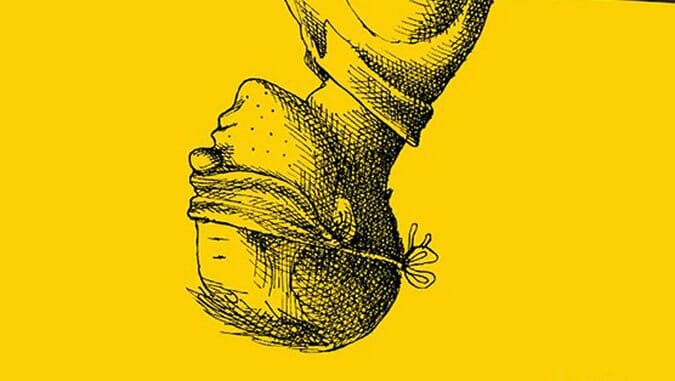Channeling Kafka in An Iranian Metamorphosis: Mana Neyestani’s Political Nightmare

It begins with a blank space, and an urgent call to fill it. That could be taken as a metaphor for any writer or artist, but in Mana Neyestani’s graphic novel, An Iranian Metamorphosis, it’s also a nerve-wrackingly literal statement. As this memoir opens, Neyestani finds himself in Turkey, seeking refuge after something — the actual event remains purposely ambiguous — has caused him to leave his home in Iran. He’s been traumatized by the experience; even as he waits in an office for refugees and attempts to summarize the events that have brought him there, he chafes under the growing anxiety that he may have exchanged one nightmarish bureaucracy for another. And, sure enough, the official shouting at him to “stay inside the frame” resurfaces throughout the narrative; the shape and layout of panels even echo the impositions and regulations that held Neyestani in place and imprisoned him in his home country.
So, yes, An Iranian Metamorphosis is quite literally a Kafka-esque situation — hence the book’s title, as well as a recurring motif of a cockroach that haunts Neyestani in detention cells, hotel rooms and airplanes. “I know the book is more The Trial than Metamorphosis, but I like the idea of ‘changing or losing the identity,’ and I found it similar to my situation,” Neyestani wrote via email from his home in France. “You wake up some day and see that you are not the person you knew anymore. You were a respectful artist before, now you are a convict. They call you racist, a menace for the society.”
As Neyestani describes in his book, he began his career drawing political cartoons, but shifted to illustrating comics for children over time. (Sohelil, a character Neyestani used in his comics for kids, periodically surfaces in An Iranian Metamorphosis to bedevil Neyestani — first in a comic invocation of writer’s block, and later under more perilous circumstances). In 2005, the newspaper he worked for, Iran, fell under more strictly-religious ownership. In 2006, Neyestani drew a strip in which the word choice of a cockroach was taken by some as having racist connotations against the Azerbaijani, a Turkish-speaking group in Iran. Existing tensions in Iranian society strained further, and protests broke out. The outcome caused Neyestani and his editor, Mehrdad Ghasemfar, to face detainment, forced into a legal and logistical nightmare: a detention of indefinite length. Later, one of the Azeri protestors briefly shared Neyestani’s cell; their interaction in the book puts the protests into a broader societal context.
For Neyestani, revisiting the work he did prior to being detailed is still difficult. “It was so ordinary and never meant to make such troubles,” he said. “I was an editorial cartoonist, and it’s not strange to face the consequences of your work, but as a cartoonist you prefer to be punished for the real meaning of your work, not misinterpretations.”
The methods Neyestani chooses to tell his story reflects his background of both cartoons and editorial work. His approach in Metamorphosis blends styles, sometimes within the same panel. He’s perfectly at home drawing characters in a realistically: along with his wife Monsoureh and his editor, Neyestani’s illustrations of himself are expressive and simple, a basic everyman amidst the distorted nightmares. Other characters are drawn in an exaggerated manner that evokes the toothy, grotesque detail of iconic horror artist Richard Corben; at times, more cartoonish characters also enter the mix.
-

-

-

-

-

-

-

-

-

-

-

-

-

-

-

-

-

-

-

-

-

-

-

-

-

-

-

-

-

-

-

-

-

-

-

-

-

-

-

-













































